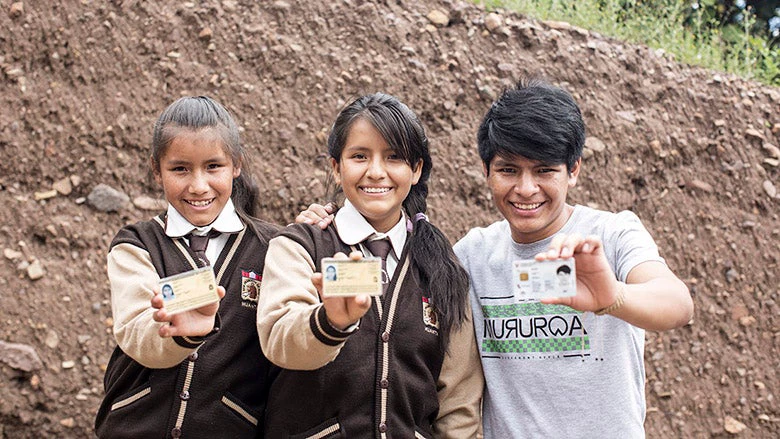
Peru has placed so much emphasis on the importance of identification that it has created a museum dedicated to it. The "Museum of Identification" in Lima demonstrates to visitors the significance of identity in the country’s narrative. In fact, the Incas, centuries before the Europeans arrived, kept track of the population by using “quipus”, an accounting tool based on strings, with each node denoting a village or community.
Peru has continued to prioritize identification, and the uniqueness of each person—long before the Sustainable Development Goals made “legal identity for all and free birth registrations” a global priority (SDG 16.9).
Learning from Peru’s experience
Peru’s national identification campaign started in 1995 after a civil insurgency had torn the country apart and caused the loss or destruction of paper-based civil registration records. The conflict left many people displaced and over 3 million Peruvians without identification. Following the conflict, Peru committed to making identification a national priority. Assuring the unique identification of citizens and residents was an important symbol of re-integration and reconciliation, especially for those with no identity documents. As a result of this commitment, Peru has accomplished near universal ID coverage today.
Peru’s ability to drive the identification agenda has inspired other countries to achieve similar results. Together with the delegation from Cote d’Ivoire and Guinea, we visited Peru last month on a South-South Exchange Program as part of the World Bank Group’s Identification for Development (ID4D) Initiative to learn from their remarkable experience.
The visit was very timely as Cote d’Ivoire and Guinea will be the first to launch the West Africa Regional Unique Identification for Regional Integration Inclusion (WURI) Program, which aims to provide to all their population with a government recognized proof of identity to enable access to services, such as health insurance, and banking.
We heard firsthand from the staff of Peru’s national identification agency, The National Registry of Identification and Civil Status (Registro Nacional de Identificación y Estado Civil or RENIEC), about the challenges they faced as they implemented the national ID system.
What makes Peru a unique case is the focus on inclusion. RENIEC made a special effort to cover the most vulnerable and isolated segments of the population: throughout the year, the agency navigated the Amazon river on army boats to reach secluded communities to register civil acts, and provide civil identification records. Cultural diversity, sensitivity to, and use of, indigenous languages was also an important focus. Not only did RENIEC ensure that the forms and information were available in some of the major language groups, it also took steps to publish books in more than 40 indigenous languages, and followed the naming practices of each ethnic group to preserve part of Peru’s cultural heritage.
Since August 2006, Peruvian authorities have been using a digital technology system to verify data for new registration, avoid document falsification, or fraud. RENIEC provides a unique identification for every person from birth, following the person through life, and allowing access to all public services such as education, health and financial inclusion. Another interesting fact about Peru’s identity management system is the national identity document (DNI) is issued to every citizen from birth.
The visit was extremely inspiring. It enabled us to ascertain the poignant similarities between Peru in the 1990s, and Cote d’Ivoire and Guinea today. Hearing directly from RENIEC provided both delegations, and our team, important insights on how to implement a robust and inclusive national digital identification system.
ID4D South-South Exchange Program
While the exchange between Peru and Cote d’Ivoire and Guinea is the most recent example, the World Bank Group’s ID4D Initiative has been fostering the exchange of knowledge among countries for many years to help countries reach the transformational potential of digital identification systems. Through the South-South Exchange Program, ID4D provides a critical platform for countries to share knowledge, best practices and lessons, to leverage the experiences of countries that have successfully implemented identification systems.
ID4D has been facilitating this kind of interaction with several other countries. India hosted delegations from the Philippines, Morocco, and Tanzania to share its lessons. Similarly, countries like Estonia, have been engaging with Rwanda, Uganda, and Vietnam regarding their experience in digital identification to access services. In fact, the ID4D team just signed a framework agreement with Estonia’s eGovernance Academy to deploy expertise in support of countries embarking on digital identification projects.
Moving forward, ID4D will continue to strengthen its platform for knowledge exchange, as we have seen firsthand that South-South learning is one of the most powerful tools we have to achieve meaningful results. For now, we know the program will allow two more countries—Cote d’Ivoire and Guinea—to get one step closer to their goal of providing identification for all.



Join the Conversation